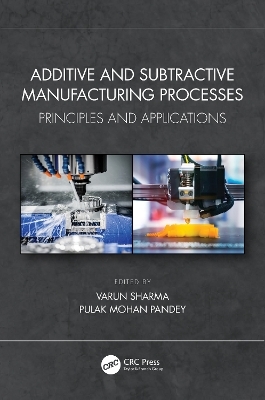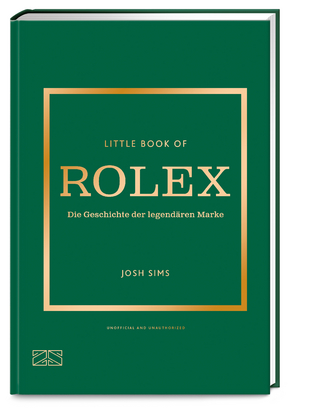
Additive and Subtractive Manufacturing Processes
CRC Press (Verlag)
978-1-032-05451-3 (ISBN)
This reference text discusses fundamentals, classification, principles, applications of additive and subtractive manufacturing processes in a single volume.
The text discusses 3D printing techniques with the help of practical case studies, covers rapid tooling using microwave sintering and ultrasonic assisted sintering process, and covers different hybrid manufacturing techniques like cryo-MQL, and textured cutting inserts. It covers important topics including green manufacturing, ultrasonic assisted machining, electro thermal based non-conventional machining processes, metal based additive manufacturing, LASER based additive manufacturing, indirect rapid tooling, and polymer based additive manufacturing.
The book:
Discusses additive and subtractive manufacturing processes in detail
Covers hybrid manufacturing processes
Provides life cycle analysis of conventional machining
Discusses biomedical and industrial applications of additive manufacturing
The text will be useful for senior undergraduate, graduate students, and academic researchers in areas including industrial and manufacturing engineering, mechanical engineering, and production engineering.
Discussing the sustainability aspects of conventional machining in reducing carbon footprint of machining by adopting different hybrid and non-conventional machining processes, this text will be useful for senior undergraduate, graduate students, and academic researchers in areas including industrial and manufacturing engineering, mechanical engineering, and production engineering.
Dr. Varun Sharma completed his B.Tech. degree from Guru Nanak Dev Engineering College in 2011securing first position and got Master’s degree from Guru Nanak Dev Engineering College in 2013 in Production Engineering specialization. He joined IIT Roorkee as a faculty member in 2018 and presently serving as assistant professor in Department of Mechanical and Industrial Engineering at Indian Institute of Technology, Roorkee, Uttarakhand, India. He has 8 years of experience in research and teaching. He has published 35 research papers in peer reviewed journals and 11 in national and international conferences. His research interest includes Conventional machining processes, Non-conventional machining processes, Machining and process optimization, Ultrasonic assisted machining, Additive manufacturing/ 3D Printing, Mechanical and biomedical applications. Dr. Pulak M. Pandey completed his B.Tech. degree from H.B.T.I. Kanpur in 1993 securing first position and got Master’s degree from IIT Kanpur in 1995 in Manufacturing Science specialization. He served H.B.T.I. Kanpur as faculty member for approximately 8 years and also completed Ph.D. in the area of Additive Manufacturing/3D Printing from IIT Kanpur in 2003. He joined IIT Delhi as a faculty member in 2004 and is presently serving as Professor. In IIT Delhi, Dr Pandey diversified his research areas in the field of micro and nano finishing, micro-deposition and also continued working in the area of 3D Printing. He supervised 41 PhDs and more than 36 MTech theses in last 10 years and also filed 22 Indian patent applications. He has approximately 201 international journal papers and 48 international/national refereed conference papers to his credit. These papers have been cited for more than 7575 times with h-index as 43. He received Highly Commended Paper Award by Rapid Prototyping Journal for the paper "Fabrication of three dimensional open porous regular structure of PA 2200 for enhanced strnegth of scaffold using selective laser sintering" published in 2017. Many of his B.Tech. and M.Tech. supervised projects have been awarded by IIT Delhi. He is recipient of Outstanding Young Faculty Fellowship (IIT Delhi) sponsored by Kusuma Trust, Gibraltar and J.M. Mahajan outstanding teacher award of IIT Delhi. His students have won GYTI (Gandhian Young Technological Innovation Award) in 2013, 2015, 2017, 2018 and 2020 .
Chapter 1 Evolution of Manufacturing: Growing on a Circular Track
Uday Shanker Dixit
1.1 Introduction
1.2 Transformation of manufacturing system: domestic-factory-domestic
1.3 Customization to mass production to mass-customization and again to customization
1.4 Importance of sustainability in manufacturing sector
1.5 Role of data and analytics in manufacturing
1.6 Influence of evolutions in material science
1.7 Automation
1.8 Future of manufacturing
1.9 Challenges
1.10 Conclusion
Chatper 2 Grinding and recent trends
Kamal Kishore, Manoj Kumar Sinha, Dinesh Setti
2.1 Introduction
2.2 Sustainable Machining Techniques
2.2.1 Minimum Quantity Lubrication (MQL)
2.2.2 Nanofluid MQL
2.2.3 Cryogenic Cooling
2.2.4 Hybrid Cooling Methods
2.3 Hybrid Grinding Techniques
2.3.1 Ultrasonic Assisted Grinding (UAG)
2.3.2 Laser-assisted Grinding (LAG)
2.4 Micro-grinding
2.5 High-Speed Grinding (HSG)
2.5.1 Creep Feed Grinding
2.5.2 High-Efficiency Deep Grinding (HEDG)
2.5.3 Speed Stroke Grinding (SSG)
2.6 Textured Grinding Wheel (TGW)
2.7 3D-printed Grinding Wheels
2.8 Artificial Intelligence (AI) in grinding
2.8.1 Self-Optimising Programs Systems
2.9 Precision Shaped Grits
2.10 Summary
Chapter 3 Recent advances in ultrasonic manufacturing and its industrial applications
Ravinder P. Singh, Vishal Gupta , Girish C. Verma , Pulak M. Pandey, Uday S. Dixit
3.1 Introduction
3.2 Basic concept
3.2.1 Mechanics of cutting UAMc process
3.2.2 Influence on the cutting mechanism
3.3 Mechatronics involved in UAMc
3.4 Ultrasonic assisted machining (UAMc) economic aspect
3.5 Influence of ultrasonic effect on various machining processes
3.5.1 UAT process
3.5.2 Ultrasonic assisted milling (UAM) process
3.5.3 Ultrasonic assisted drilling
3.6 Industrial application of UAM and RUD process
3.6.1 Case study on UAM process
3.6.2 Case study of RUD in biomedical application
3.7 Conclusion
Chapter 4 Environmental Sustainability Assessment of a Milling Process using LCA: A Case Study of India
Nitesh Sihag, Vikrant Bhakar, Kuldip Singh Sangwan
4.1 Introduction
4.2 Materials and Method
4.2.1 Goal and Scope Definition
4.2.2 Functional Unit and System Boundary
4.2.3 Reference Factory and HVAC System
4.2.4 Inventory Analysis
4.3 Results and Discussion
4.3.1 Endpoint Assessment
4.3.2 Midpoint Assessment
4.4 Practical Implications and Recommendations
4.5 Sensitivity Analysis
4.6 Summary
Chapter 5 Mechanical based non-conventional machining processes
Rajesh Babbar, Aviral Misra, Girish Verma, Pulak M. Pandey
5.1 Introduction
5.2 Abrasive jet machining
5.2.1 Mechanism of material removal in AJM
5.2.2 Process parameters of AJM
5.2.3 Applications of AJM
5.3 Abrasive water jet machining
5.3.1 Material removal mechanism in AWJM
5.3.2 Process parameters of AWJM
5.3.3 Cutting geometry in AWJM
5.3.4 Applications of AWJM
5.4 Magnetic abrasive finishing
5.4.1 Material removal mechanism in MAF process
5.4.2 Process parameters of MAF
5.4.3 Advances and application of MAF
5.4.4 Future scope of MAF
5.5 Abrasive flow machining
5.5.1 Mechanism of material removal in AFM
5.5.2 Process Parameters of AFM
5.5.3 Developments and application of AFM
5.5.4 Future scope of AFM
5.6 Conclusion
Chapter 6 Thermal Energy Based Advanced Manufacturing Processes
Hardik Beravala, Nishant K. Singh
6.1 Introduction
6.2 Air/gas assisted EDM
6.3 Magnetic field assisted EDM
6.4 Magnetic field and Air/gas Assisted EDM
6.5 Conclusions
Chapter 7 Polymer based additive manufacturing
Narinder Singh, Buta Singh
7.1 Introduction
7.2 Various techniques used in AM
7.2.1 Fused deposition modeling
7.2.2 Stereolithography (SLA)
7.2.3 Laminated object manufacturing
7.2.4 Selective laser sintering (SLS)
7.2.5 Laser engineered net shaping (LENS)
7.2.6 Polyjet
7.3 HT thermoplastics in additive manufacturing: Structure
7.4 HT engineering thermoplastics in PBF
7.5 High performance polymers (HPPs)
7.5.1 Amorphous HPPs
7.5.2 Polysulfone
7.5.3 Polyetherimide
7.5.4 Poly (phenylene sulfide) and Semi-crystalline HPPs
7.5.5 Polyether-ether-ketone
7.5.6 Liquid crystalline polymers
7.5.7 Nano-based materials/Innovative polymers
7.5.8 Poly butylene succinate
7.5.9 Poly hydroxy alkanoates
7.5.10 Lignin
7.6 Challenges in printing with HT engineering thermoplastics
7.7 Conclusions
Chapter 8 Recent Research progress and Future Prospects in the Additive Manufacturing of Biomedical Magnesium and Titanium Implants
Haytham Elgazzar and Khalid Abdelghany
8.1 Introduction
8.2 Additive Manufacturing and fabrications challenges of biomedical metal implants
8.3 The fabrication of Ti6Al4V implants using SLM process
8.4 Biomedical Ti6Al4V implants: Case studies
8.5 The fabrication of Mg implants using SLM process
8.6 Post-processing of SLM products
8.7 Summary and future works
Chapter 9 Indirect rapid tooling methods in additive manufacturing
Gurminder Singh, Pawan Sharma, Kedarnath Rane, Sunpreet Singh
9.1 Introduction
9.2 Indirect rapid tooling
9.3 Direct rapid tooling
9.4 Soft Tooling
9.5 Pattern quality by AM process
9.6 Different rapid tooling processes
9.6.1 Electroforming
9.6.2 Casting
9.6.3 Investment casting
9.6.4 Sand casting
9.7 Sintering
9.7.1 Conventional Sintering
9.7.2 Microwave Sintering
9.7.3 Ultrasonic Vibration Sintering
9.8 Applications of indirect RT methods
9.8.1 Machining tools
9.8.2 Biomedical
9.8.3 Others
9.9 Benefits of rapid tooling
9.10 Future Scope and summary
Chapter 10 Laser Additive Manufacturing of Nickel Superalloys for Aerospace Applications
S K Nayak , A N Jinoop, S Shiva, C P Paul
10.1 Introduction
10.2 LAM of Ni-superalloys
10.3 LAM processes
10.4 LAM Processed Ni-Superalloys for Aerospace Applications
10.4.1 Inconel 718 (IN718)
10.4.2 LPBF of IN718
10.4.3 LDED of IN718
10.4.4 Inconel 625 (IN625)
10.4.5 LPBF of IN625
10.4.6 LDED of IN625
10.5 Hastelloy-X(HX)
10.5.1 LPBF of HX
10.5.2 LPBF of HX
10.6 Waspaloy
10.6.1 LPBF of Waspaloy
10.6.2 LPBF of Waspaloy
10.7 CM247LC 235
10.7.1 LPBF of CM247LC
10.7.2 LPBF of IN625
10.8 Recent Trends in LAM of Ni-Superalloys
10.8.1 Case studies for LAM built Ni super-alloys for aerospace applications
10.9 Future Scope
10.10 Conclusions
Chapter 11 Impact of enabling factors on the adoption of additive manufacturing in the automotive industry
Kshitij Sharma, Maitrik Shah, Shivendru Mathur, Neha Choudhary, Varun Sharma
11.1 Introduction
11.2 Research motivation
11.3 Literature review
11.3.1 Enablers
11.3.2 Research gap and objective
11.4 Research method
11.5 Methodology
11.6 Interpretive structural modeling (ISM)
11.7 Analytic network process (ANP)
11.8 Application and results
11.8.1 ISM APPLICATION
11.8.2 ANP application
11.9 Discussion
11.10 Managerial implication
11.11 Conclusions
Chapter 12 Thermal Analysis and Melt Flow Behavior of Ethylene Vinyl Acetate (EVA) for Additive Manufacturing
Vivek Dhimole, Narendra Kumar, Prashant K. Jain
12.1 Introduction
12.2 Material and methods
12.3 Results and Discussions
12.3.1 Thermal analysis of Material Deposition Tool system
12.3.2 Simulation of melt flow in Barrel
12.3.3 Simulation of melt flow in Nozzle
12.3.4 Free extrusion and swelling of melt
12.3.5 Evolution of temperature distribution along the raster
12.4 Conclusion
Chapter 13 Directed Energy Deposition for metals
Nitish P. Gokhale and Prateek Kala
13.1 Introduction:
13.2 Classification of DED processes:
13.3 Material feeding:
13.3.1 Wire Feeding:
13.3.2 Omni-directional wire feeding
13.3.3 Powder Feeding:
13.4 Materials for DED processes:
13.5 Influence of process parameters:
13.6 Mechanical properties and microstructure:
13.7 Advantages and disadvantages of DED processes:
| Erscheinungsdatum | 28.10.2022 |
|---|---|
| Zusatzinfo | 41 Tables, black and white; 43 Line drawings, black and white; 53 Halftones, black and white; 65 Illustrations, color; 31 Illustrations, black and white |
| Verlagsort | London |
| Sprache | englisch |
| Maße | 156 x 234 mm |
| Gewicht | 600 g |
| Themenwelt | Kunst / Musik / Theater ► Design / Innenarchitektur / Mode |
| Technik ► Umwelttechnik / Biotechnologie | |
| ISBN-10 | 1-032-05451-4 / 1032054514 |
| ISBN-13 | 978-1-032-05451-3 / 9781032054513 |
| Zustand | Neuware |
| Haben Sie eine Frage zum Produkt? |
aus dem Bereich


